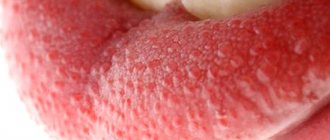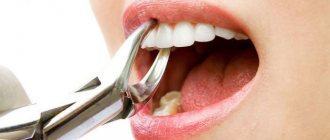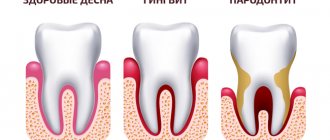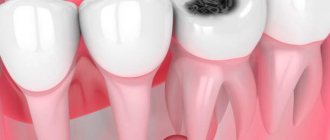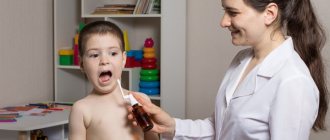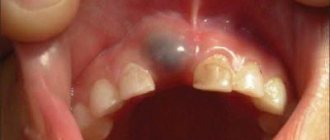Periostitis is a purulent inflammation of the periosteum, the tissue covering the bone of the upper or lower jaw. Over time, the inflammation spreads to other tissues of the oral cavity , and a painful and unpleasant abscess can grow on the gum.
Periostitis is of two types: acute and chronic . the acute one , it goes on very quickly. Inflammation is manifested by asymmetric swelling of the cheek on the side of the diseased tooth and enlargement of the lymph nodes, and an increase in temperature is observed. Chronic periostitis can pass without obvious symptoms, while negatively affecting the condition of the child’s teeth, destroying them from the inside. The chronic form often occurs due to untreated acute periodontitis, pulpitis or due to injury.
Quincke's edema in children
- Symptoms of the disease
- How does Quincke's edema begin in a child?
- Causes
- First aid
- Treatment of Quincke's edema in children
Attacks most often occur in children with urticaria. Pediatricians associate swelling with hay fever, bronchial asthma, and atopic dermatitis.
Important! This is a dangerous condition, which in a quarter of cases provokes swelling of the larynx.
Quincke's edema occurs in newborns and older children. Its nature is most often allergic, but this phenomenon can be hereditary and also have no clear origin. Source: I.I. Balabolkin. Urticaria and angioedema in children // Pediatrics, 2009, v. 87, no. 2
The prognosis is usually favorable; it becomes poor with frequent relapses and associated swelling of the internal organs and larynx. The consequences may be anaphylactic shock, bronchospasm.
For prevention, in some cases vaccination is carried out. Its necessity is determined individually. Clinical recommendations for parents: provide the child with a low-allergen diet, take antihistamines at intervals recommended by the doctor, minimal or no contact with the allergen.
Prevalence and routes of infection
Most often, adenoviruses enter the body by airborne droplets, that is, in the usual way for any virus from the ARVI group. Much less often, infection occurs through contact. The child played with a sick friend's toy and then rubbed his eyes - a standard infection scenario.
In fact, the human body must protect itself from an infectious disease; immunity comes to the rescue. But in fact, weakened by the cold season, the child’s local immunity is not able to resist the virus at the main entry gate. General immunity, due to age, is also not sufficiently resistant to viral infection. This is where the statistics show that children get sick much more often than adults.
Adenoviruses account for about 17% of all cases of acute respiratory diseases. Considering that there are more than 100 viral pathogens, and that there are also bacterial pathogens, the figure on a general scale is impressive2.
Almost always, adenovirus infection occurs in the form of an epidemic outbreak, that is, a group of children in contact with each other is affected. The virus can spread throughout the body, diligently multiplying, within 1-3 weeks.
Symptoms of the disease
The reaction develops rapidly; signs of angioedema in children are swollen lips, neck, and face. The upper torso, hands, feet, and genital area are often affected. Quincke's edema is visible in the eyes of a child - the eyelids swell on one or both sides.
- When the tonsils are affected, the picture is similar to a sore throat.
- Edema of the larynx is indicated by a hoarse voice, difficulty breathing, a gusty cough, blue discoloration and then gradual paleness of the skin.
- Swelling that appears in one area may occur in another. This mainly applies to large-scale swelling.
- When the mouth and tongue swell, speech becomes difficult.
- If the process is localized in the gastrointestinal tract, the child may complain of tingling of the tongue, followed by diarrhea and vomiting, and sharp pain in the intestinal area.
- Rarely, swelling of the meninges occurs. With it, the child cannot fully tilt his head forward, complains of a headache, and behaves inhibited. Convulsions and vomiting may occur.
- If only the skin is affected, joint pain, fever may appear, and the child may lose consciousness.
The pathological condition can last from an hour to several days.
How does angioedema begin in a child?
Immediately after contact with the allergen, the listed symptoms increase sharply. This happens in a matter of minutes. Source: G. I. Smirnova. Urticaria and Quincke's edema // Allergic diseases in children. Ed. M.Ya. Studenikina, I.I. Balabolkina. M.: Medicine, 1998: 279-287 If you press on the swollen area, the child will not experience pain, but you will feel a dense swelling, on which, after pressing, there will be no characteristic depression.
Causes and risk factors
The mucous membrane of the child's oral cavity is often injured. The appearance of ulcers can be caused by temperature effects (hot food and drinks), biting the inner surface of the cheeks or lips; damage by sharp edges of the filling, braces or the tooth’s own tissues in case of chipped enamel. Normally, the immune response allows the pathological process to be quickly eliminated, the mucous membrane heals, and bacteria do not have time to cause severe inflammation and ulceration.
Weakened children's immunity cannot cope with this task, which leads to the development of aphthous stomatitis. A small number of opportunistic bacteria that populate the oral cavity begin to actively multiply. Often the disease occurs against the background or as a result of a severe infection: influenza, ARVI, acute tonsillitis, infectious mononucleosis, etc.
Main risk factors:
- food allergies, allergic reactions to hygiene products, such as toothpaste;
- deficiency of vitamins and microelements due to a strict diet or impaired digestion of food;
- hereditary predisposition;
- foci of infection in the oral cavity: caries, chronic periodontitis, periodontitis, gingivitis;
- frequent respiratory diseases;
- severe systemic diseases: pathologies of the endocrine system, blood vessels, metabolic disorders, etc.
Ask a Question
Causes
A complex of immunological reactions is most often caused by:
- Food;
- medicines;
- volatile allergens (pollen, chemicals, etc.);
- insect bites.
The disease may be non-allergic in nature. In this case, in addition to allergens, it is caused by: stress, infectious diseases, external factors (for example, hypothermia), intoxication of the body. Source: A. V. Lyapunov. Urticaria and Quincke's edema in children // Children's allergology. Ed. A.A. Baranova, I.I. Balabolkina. M.: GeotarMedia, 2006; 486-497.
Medicine also knows quite a lot of cases where the reason for such a reaction of the body has not been established.
Prevention
The development of the disease can be prevented with the help of general strengthening measures: it is important to adhere to a daily routine, provide nutrition taking into account the body’s needs for vitamins and minerals, and pay attention to the prevention of infectious diseases.
The development of stomatitis can be avoided using simple measures, such as:
- regular oral hygiene, which should begin from the moment the baby’s first tooth appears;
- use of toothpastes without sodium lauryl sulfate. This component increases the risk of developing the disease;
- routine examinations by a pediatric dentist;
- rinsing the mouth after every meal;
- limited consumption of sweets.
Pediatric dentists at STOMA clinics are ready to help a child of any age. By contacting us, you can be confident in the professionalism of our specialists. We have developed effective treatment regimens for aphthous stomatitis in children. Doctors will talk in detail about preventing relapses and give recommendations on maintaining oral health.
First aid
call an ambulance immediately . Doctors may decide on emergency hospitalization if the patient has difficulty breathing, a swollen tongue, or symptoms indicating intestinal damage.
What to do before the doctors arrive?
First aid, which should be provided at the first symptoms of angioedema in children, involves clearing the airways, checking breathing intensity, heart rate, and blood pressure. Sometimes it is necessary to perform cardiopulmonary resuscitation, so after the first case, parents are recommended to take first aid courses. At the final stage, medications should be administered to the child.
First aid equipment includes:
- glucocorticosteroids (“Prednisolone”, “Dexamethasone”);
- antihistamines;
- adrenalin.
Sequence of administration: adrenaline, then glucocorticosteroid, then antihistamine. If the reaction is moderate, then adrenaline is excluded.
| Adrenalin | It is injected intramuscularly into the thigh (middle third outside) at the rate of 0.01 mg for each kg of the child’s weight. If there is no effect, then the injections are repeated every 15 minutes. |
| Glucocorticosteroids | Injected intramuscularly into the buttock or intravenously. You can pour the medicine from the ampoule under the tongue - this way the effect will come faster. The dosage of Prednisolone is from 60 to 150 mg, Dexamethasone is from 8 to 32 mg. |
| Antihistamine | Intramuscular injection is preferable. It is possible to take a pill, but the effect will come later. The dosage depends on the medicine. For example, “Loratadine” – 10 mg, “Cetrizine” – 20 mg. |
Important! In case of swelling of the larynx, a tracheostomy is performed urgently.
Treatment of angioedema in children
- stopping contact with the allergen;
- removal of the allergen from the body (sorbents, drinking plenty of fluids);
- the use of antihistamines, glucocorticosteroids, diuretics and other drugs, depending on individual indications.
The treatment plan may vary and include other interventions and complex drug therapy. It depends on the type of disease, the number of relapses and other factors. It is necessary to obtain specialist advice.
Sources:
- I.I. Balabolkin. Urticaria and angioedema in children // Pediatrics, 2009, v. 87, no. 2.
- G. I. Smirnova. Urticaria and Quincke's edema // Allergic diseases in children. Ed. M.Ya. Studenikina, I.I. Balabolkina. M.: Medicine, 1998: 279-287.
- A. V. Lyapunov. Urticaria and Quincke's edema in children // Children's allergology. Ed. A.A. Baranova, I.I. Balabolkina. M.: GeotarMedia, 2006; 486-497.
Grek Elena Anatolyevna Clinic
Author of the article
Grek Elena Anatolyevna
Doctor of the highest qualification category
Specialty: allergist
Experience: 24 years
The information in this article is provided for reference purposes and does not replace advice from a qualified professional. Don't self-medicate! At the first signs of illness, you should consult a doctor.
Republican Children's Clinical Hospital
What is lymphadenopathy in a child? This is an enlargement of lymph nodes in one or more areas of the body due to a disease. What are they needed for? Lymph nodes are “customs” for a large area of the human body. Although these are small round formations the size of beans or peas, they are nevertheless intended to be the first barrier to pathogens of infectious diseases: bacteria, viruses, fungi, protozoa, preventing the spread of infection deep into the body. Therefore, lymph nodes are located singly or in groups, but always in strategically important places.
Lymphadenopathy is a symptom of the disease. Which one exactly? The doctor will answer this question. Unfortunately, this important symptom is not always assessed adequately and in a timely manner. Parents should know that if one or more enlarged lymph nodes are detected in one group, the child should be consulted with a pediatrician. In most cases, the cause of enlarged lymph nodes is infectious processes (viral, bacterial, fungal, protozoal), less often - autoimmune diseases, storage diseases. However, such causes can also be malignant neoplasms.
Among infectious causes, enlargement of lymph nodes is most often caused by staphylococcal or streptococcal infections - tonsillitis, pharyngitis, scarlet fever, complicated caries, boils, diseases of the upper respiratory tract, and less often - diphtheria, tuberculosis, plague. In this case, complaints, a thorough examination, medical history, analysis of Mantoux reactions and the vaccination calendar will help determine and prescribe treatment. Often the cause is “cat scratch” disease, when a child, a few days or even 2-3 weeks after a child has been scratched on the arms or legs by a tormented cat, the lymph nodes of the axillary or groin areas, respectively, enlarge and become painful. In this case, the doctor will prescribe adequate antibacterial therapy.
Among viral infections, one should think about rubella, chickenpox, mumps, cytomegalovirus, infectious mononucleosis, and HIV infection. To diagnose these conditions, an increase in body temperature, a rash on the skin and mucous membranes, pain when opening the mouth, puffiness of the face, snoring at night, purulent sore throat, and the presence of contacts with patients the day before will be important.
However, with this variety of causes, a doctor who is alert to cancer will identify a group of patients with suspected malignant tumor or blood disease and refer the child to an oncohematologist for consultation.
When treating cancer, early diagnosis is the most important step on the path to recovery. Treatment of a patient at the first stage is the most promising and cheapest. Unfortunately, many people are convinced that malignant tumors practically never occur in children. However, it is not. Being, fortunately, a fairly rare disease, malignant tumors rank second after injuries among the causes of death in children under 15 years of age. As data from statistical studies show, every year out of 100 thousand children of this age, 14-15 are diagnosed with malignant neoplasms.
Symptoms that should alert a child with lymphadenopathy include significant weight loss in a short time, persistent loss of appetite, bone pain, increased fatigue (the child gets tired faster than usual, forgetting even about his most favorite games), lethargy, pale skin, bruises on the body without obvious injuries, hemorrhages in the mucous membranes, unexplained rises in body temperature.
But despite the presence or absence of these symptoms in the child, parents should understand that until the reasons are determined, they should not warm the lymph nodes, carry out any physical procedures (electrophoresis, applications, etc.), or lubricate them with anything. Any physical procedures on the area of the lymph nodes are contraindicated, as they can aggravate the process, causing rapid progression and thus reducing the chances of recovery with even more expensive treatment. There are cases when such errors became fatal.
Thus, the attentiveness and prudence of parents plays a huge role in timely diagnosis and initiation of treatment. Who, if not parents, will be able to notice changes in their child’s condition in time - and contact specialists in time, without making mistakes along the way? As American oncologist Charles Cameron wrote: “Be neither too careless about the possibility of cancer in children nor too worried. But be on your guard!”
| Pediatric hematologist, KRU "DKB" | Tarasenkova A.A. |
Answer
Prices
| Name of service (price list incomplete) | Price |
| Appointment (examination, consultation) with an allergist-immunologist, primary, therapeutic and diagnostic, outpatient | 1750 rub. |
| Prescription of treatment regimen (for up to 1 month) | 1800 rub. |
| Consultation (interpretation) with analyzes from third parties | 2250 rub. |
| Consultation with a candidate of medical sciences | 2500 rub. |
| Allergen-specific immunotherapy (ASIT) - maintenance course (excluding the cost of the drug) | 8100 rub. |

